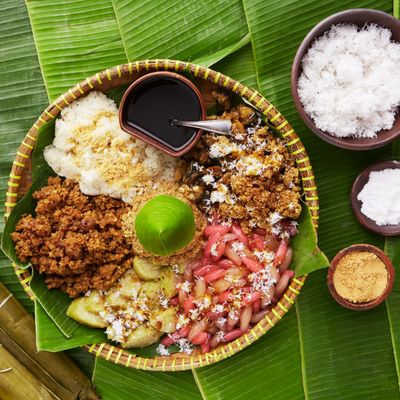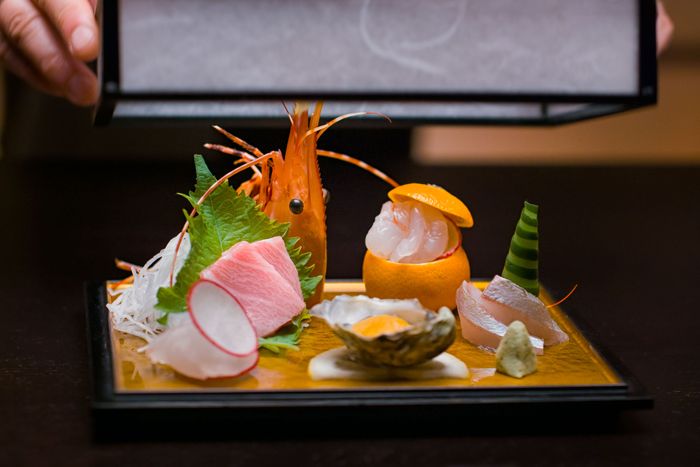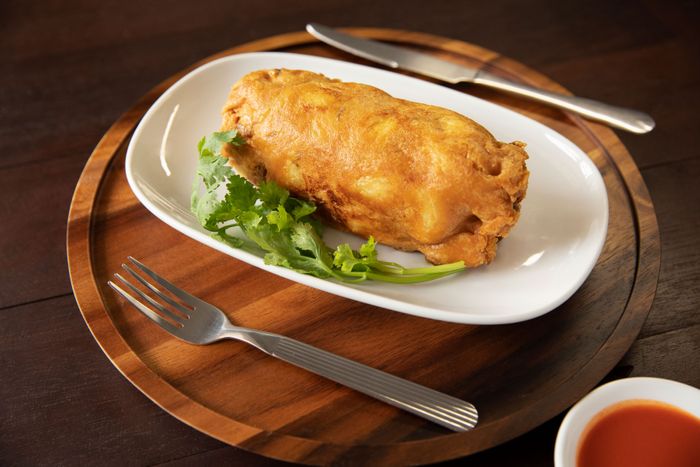
On Netflix’s “global cooking competition” The Final Table, the food looks really, really good. The reality show, which debuted in November, challenges chefs from around the world to prepare flawless riffs on the cuisines of about a dozen countries. Each dish is caressed by the camera, lingered on in close-up hungrily, longingly; every morsel shimmers in sumptuous high definition. Watching the show, you can’t help but want to eat. (Several times while watching, I was impelled to order a disappointing approximation from Seamless.)
The Final Table bears a certain resemblance to another, earlier reality competition: Ramsay’s Best Restaurant, a nine-part British series hosted by Gordon Ramsay. Like The Final Table, Ramsay’s Best Restaurant pits celebrated chefs against one another in a contest of culinary skill, and their finest efforts are surely delectable. But by comparison, they just look a little … plain. On The Final Table, dishes are shot so lavishly they almost glisten — each taco, each feijoada, is relished in slow-motion pans and tender zooms. On Ramsay’s Best Restaurant, even Michelin-starred masterpieces seem stark and spartan, shot without flair.
Why such a conspicuous difference? It’s not that Ramsay’s Best Restaurant is some artless mediocrity and The Final Table an exemplar of televisual panache. They simply represent two different eras of a genre that evolved suddenly in ways surprising and quietly revolutionary. Between 2010, when Ramsay’s Best Restaurant was made, and 2018, when The Final Table was, food TV underwent a behind-the-scenes transformation that radically changed how we expect meals to look on the small screen. To put it another way: Ramsay’s Best Restaurant looks lackluster because it could. The Final Table looks great because it has to.
This massive shift is all thanks to a pair of documentarians named David Gelb and Brian McGinn and the stylish food show they created for Netflix in 2015. It’s called Chef’s Table, and it changed the way documentary TV looks.
Even if you’ve never seen an episode of Chef’s Table, you’ll know what Chef’s Table looks like, because in the wake of Chef’s Table, that’s how everything seems to look. Chef’s Table pioneered that slick, frictionless aesthetic that’s ubiquitous in food documentaries (and nonfiction television of all kinds) today — the plush, precise look en vogue that makes the humblest foodstuffs scintillate, so crisp on a 4K TV they seem edible. Whether a quenelle of caviar crowned with gold leaf or a chunky wheel of Parmigiano-Reggiano, the objects under the show’s gaze are treated with a care that verges on reverence.
“It’s hard for me to think of anything prior to Chef’s Table that was like Chef’s Table,” says Adam Bricker, one of the show’s directors of photography. “The Gordon Ramsay–type shows are in a different category of filmmaking. It’s a different world than we’re living in.”
Those previous shows, Bricker says, are like any other reality shows, except they happen to be about food. A cooking competition of old, like Ramsay’s Best Restaurant, is made in a totally different way than Chef’s Table, with a different ethos and different approach. “That show has probably two or three camera operators who are one-man bands, and the objective is to, like, hose down the content, then build a reality story in the edit,” he explains. “Whereas we’re coming from a feature-filmmaking background, a narrative background. We’re much slower. We’re way more deliberate. They’re very different things.”
The unconventional approach, Bricker says, had less to do with a desire to be unique than with mere inexperience in the field. “It originally came from a place of ignorance,” he says. When he and the rest of the Chef’s Table crew set out for Australia to shoot the first episode, Bricker compiled a list of equipment for the shoot and the local line producer, a veteran of reality-TV productions, “immediately raised flags,” Bricker says. “He saw what we had and was like, How is this gonna work? It was just so foreign to him that you would shoot a documentary with this cumbersome narrative-cinema package.”
“Maybe if I had shot a lot of Gordon Ramsay stuff prior, or done documentary work in general, I would have known there would be a ton of inefficiencies with the gear order,” he admits. “But we weren’t really thinking about doing anything efficiently. We were taking our time. We were just thinking of making a movie.”
It wasn’t just Bricker who had little experience making this kind of thing. It was everyone — and that was the point. “Nobody on our crew had ever done a food show before,” says David Gelb, co-creator, executive producer, and sometime director of Chef’s Table. “We were trying to make a kind of food show that had never been done before. If we’re trying to make a completely different food show, then it doesn’t make sense to work with people who have done food shows.”
We tend to think of inexperience as a shortcoming. For Chef’s Table, it was an asset. “The cinematographers we were using did not have, like, ten years of vérité filmmaking experience,” says Brian McGinn, Gelb’s partner on the show. “They came from different backgrounds and brought narrative experience to Chef’s Table. That kind of narrative quality — in terms of how scenes are constructed and the way that things feel in the show — became a signature element and made it feel different than the kind of traditional documentary that had been very popular.”
Shane Reid, a Chef’s Table colorist responsible for fine-tuning the image in postproduction, says that the unusual approach was obvious from the beginning. “This whole thing was gonna be viewed as a film. We’re making a film here,” he recalls. “It’s technically a TV show. Technically a documentary. But this is a film, with full contrast and deep, saturated colors.” Reid says that when he first began work on the series, he was struck by how different the ethos was from other shows. Four years later, he says, “it’s almost like the playbook for documentaries.”
The first pages of that playbook came together a couple of years before Chef’s Table, when David Gelb made a name for himself as a filmmaker with Jiro Dreams of Sushi, a documentary feature about a gifted octogenarian sushi chef in Japan. Though it would seem familiar enough now, at the time Jiro looked quite unlike most other documentaries — a striking, poetic film with dramatic visuals and a soundtrack by Philip Glass. “What I was looking for was to make it look like a movie,” Gelb recalls. “I didn’t want it to feel like a normal documentary. I wanted it to feel like a real movie.”
Gelb drew from the stylized docs of Errol Morris, such as The Fog of War and The Thin Blue Line (hence the Philip Glass), as well as the more experimental films of Ron Fricke and Godfrey Reggio, whose Baraka and Koyaanisqatsi are full of slow-motion tracking shots and gorgeous macro photography (and, again, Philip Glass). He had two tenets for the film: cinematic presentation and emotional storytelling. The rest mattered less. “You’re not going to learn a whole lot about how to cook, but you will get a beautifully told story,” he says. “And that was kind of the DNA of the show.”
So why had nobody thought to make a food documentary that looks like Koyaanisqatsi before Jiro? Because pulling it off was ludicrously hard. Jiro was shot on the heavy-duty, cinema-grade RED One digital camera — the same camera David Fincher had used to shoot The Social Network a year earlier — in the days when shooting docs on shaky handheld video cameras was the norm. The RED One camera, Gelb says, was “completely nonfunctional” for a documentary shoot. “It’s incredibly heavy. It took 90 seconds to boot up. It would overheat all the time. And the record button was right next to the power button, so half the time I was shooting I would accidentally shut the camera off.”
Somehow, Gelb pulled it off. The result was a food documentary of cinematic visual caliber — a movie about sushi with the visual flair of David Fincher. It was also a certified indie-doc hit, earning $2.5 million domestic, securing an enviable 99 percent “Fresh” rating on Rotten Tomatoes, landing Best Documentary nominations and awards from international critics’ associations, and placing on dozens of year-end Best Film lists.
Chef’s Table is a kind of long-form expansion of Jiro Dreams of Sushi, or put another way, Jiro is like a pilot episode of Chef’s Table. And while the RED cameras the production uses now are much improved over the early RED One (they boot faster, for one), the approach to making the show is still punishingly tough. “We don’t make Chef’s Table the easy way,” McGinn says. “It’s not an easy show to do. Instead of flying in and doing an hour-long episode in a day, when we make an episode of Chef’s Table, it’s eight, nine days. We’re spending the time to make sure we can do it in a way that matches the movielike quality David established with Jiro and that we want to continue pushing forward from there.”
Since its April 2015 debut, the Chef’s Table style has gone from cutting edge to the prevailing TV norm. It became a hit precisely because it looked better than any of its contemporaries; today, its contemporaries, from The Final Table to Ugly Delicious to Chopped and beyond, look essentially the same. After six seasons — as well as a new, kind of spinoff Street Food, which premiered on Netflix from Gelb and McGinn last week — Chef’s Table has become the definitive model for this sort of television. If you want to make a show about food in 2019, Chef’s Table is the gold standard for how the food ought to look.
“My show couldn’t have existed without their show,” says Samin Nosrat, creator and host of Netflix’s food travel series Salt Fat Acid Heat. “It’s so beautiful. All of that fancy equipment, and those cameras, and the stop motion, and the music, right? All of that, it elevates the subject in this way that isn’t really able to happen when it’s just studio lighting and two fixed cameras.” On Salt Fat Acid Heat, Nosrat travels the world, visiting small towns and remote farms to learn how to grind pesto in a pestle, or how to look for the right marbling in a slab of beef. It’s charming and generous and informative, and naturally, it also looks great.
“The simplest things get the movie-star treatment,” Nosrat says. “A chicken. Or a focaccia. I didn’t know anything about filmmaking, but I knew what my goal was, which was to make people want to cook something. The fact that a lady making rice and fish in a pot gets three cameras and dramatic lighting, that’s what was important to me.”
But as much as the influence of Chef’s Table looms over shows like Salt Fat Acid Heat, it’s the sort of super-force that begs for a little resistance. Norsat says she’s glad she had Chef’s Table “to look to and respond to,” and she jokes that on set, they knew what they needed to avoid. “We had a joke the whole time: No classical music. No slo-mo,” she says with a laugh.
Gelb and McGinn are perfectly aware of their influence. McGinn says it’s “super-flattering” when other shows seem to follow their example; Gelb concedes, too, that “other shows have to a certain extent caught up” to what they’re doing, in terms of staging and cinematography. Shane Reid, the colorist, says that when Gelb and McGinn developed the language of Chef’s Table, they “gave that to the world.”
“They put it out there, and it changed the game,” Reid says. “I see that everywhere. Doesn’t matter what genre is. True crime looks like that. A cinematic experience like that, it’s now a prerequisite. That’s the pitch now: Chef’s Table for wine. Chef’s Table for cars. Chef’s Table for lens-making.” It’s mainly on-screen haute cuisine that tends to receive the Chef’s Table treatment, but Reid is right that Gelb and McGinn’s influence is felt in other genres, especially within the Netflix bubble: From dolly shots in interior-design show Amazing Interiors to time-lapse footage in behind-the-scenes miniseries 7 Days Out, the visual language they coined really does seem inescapable.
Gelb points out that the slo-mo and the classical music — the theme song for Chef’s Table is a bit of Vivaldi, not so subtly — are as easily caricatured as they are stolen wholesale. “There have been some really well-made parodies of the show on YouTube.” He gives high marks to a 2016 Documentary Now! parody of Jiro Dreams of Sushi called Juan Likes Rice and Chicken, which he says really nails the look and style.
“It makes us realize that we have to push our storytelling forward,” Gelb says. A style that can be easily parodied, after all, is a style at risk of growing stale. “We can’t just take it for granted that the show is going to look beautiful and that’ll be enough.”



